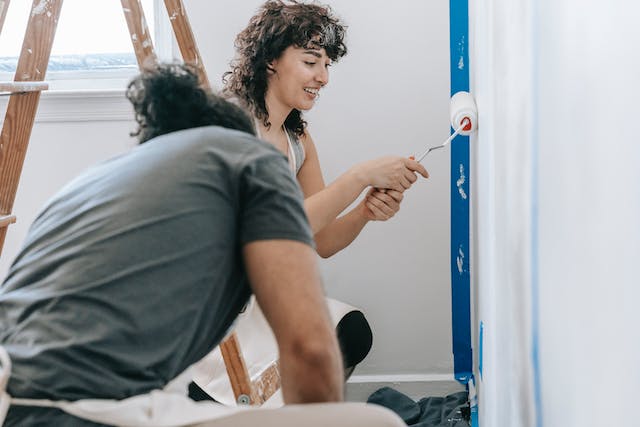
A home upgrade project is an exciting opportunity to refresh and renew your living environment. This transformative process is not just about change; it’s about creating a space that truly reflects who you are. Thoughtful planning and strategic upgrades can dramatically enhance the functionality and aesthetics of your home. As we explore elevating your space before and after moving, remember that each decision, from paint colors to furniture selection, contributes to the overall feel of your home. For those about to move, consider how your current furnishings will fit into your new space. Will they complement the layout and style of the new environment? Similarly, for those who have recently moved, it’s an opportune time to assess which changes will make your new house feel like a home.
Pre-Move Planning
Effective relocation planning starts with a clear vision of your desired space. This initial step will set the tone for the entire moving process. Try the following:
⦁ Imagine how you want each room to look and feel. When renovating a home, consider factors like the amount of natural light, color schemes, and furniture layout.
⦁ Assess potential upgrades for your new home. It could involve simple changes like a fresh coat of paint or more significant renovations such as installing new flooring.
⦁ Create a checklist of desired improvements and research the costs involved.
⦁ Identify feasible upgrades and prioritize them based on your needs and preferences.
⦁ Establish a realistic budget encompassing all potential costs, from moving expenses to home improvement projects. Allocate funds for each upgrade and stick to your budget to avoid overspending.
Declutter and Organize
Decluttering is essential in preparing for a move, as it simplifies the process and transforms your living space. Start by sorting your belongings into categories such as keep, donate, sell, and discard. This systematic approach makes it easier to identify essential items and those no longer needed. One practical tip is to tackle one room at a time to avoid feeling overwhelmed. In each room, focus on clearing out closets, drawers, and shelves.
Be honest about the utility and emotional value of each item. If you haven’t used something for over a year, it might be time to let it go. Use resources like donation centers, online selling platforms, and recycling programs for efficient decluttering. Donation centers can be excellent destinations for items in good condition, while online platforms can help you sell items of value.
Simplifying the process, decluttering alters your living space significantly
Designing Your Dream Space: A Pre-Move Blueprint
Designing your dream space while still in your old home offers a unique opportunity to plan meticulously and create a vision for your new environment:
⦁ Choose a color scheme that reflects your style and the ambiance you wish to create. Soft, neutral colors can create a calming atmosphere, while bold hues add energy and character to your space. With this in mind, consider the themes that resonate with you.
⦁ Ensure that your theme choice reflects your personality and lifestyle, whether it’s a minimalist, modern, or rustic style. This thematic approach helps in making consistent design choices throughout your new home.
⦁ Consider both aesthetics and functionality when selecting furniture and decor. Opt for pieces that complement your chosen color scheme and theme.
⦁ Incorporate decor elements that add a personal touch, like artwork or family photos.
Elevating Your Space Before and After Moving
Elevating your space before and after moving requires a strategic approach to ensure continuity in design and a smooth transition in both style and functionality. Identify key design elements that define your current space prior to the move. These could include specific color palettes, art pieces, or unique lighting fixtures.
Similarly, consider the functionality of your residence. Identify what works well and what needs improvement, and set realistic expectations. For instance, if your current living room setup facilitates easy conversation and relaxation, aim to replicate this layout in your new home.
On the other hand, if some aspects hinder functionality, such as insufficient lighting or cramped furniture arrangement, use this as an opportunity to refine your design in the new space. Lastly, document your current space with photos or sketches. This visual reference can be invaluable for replicating or improving your current design.
Elevating your space before and after moving demands a strategic methodology, guaranteeing consistent design flow and seamless transition.
Transitioning to Your New Home
To ensure a smooth transition, consider the logistics of moving carefully. Hiring a reputable moving company like mod-movers.com can be a game-changer. They specialize in customized moves and work with state-of-the-art equipment. They use safe and secure moving trucks, which is imperative when handling your belongings with care and transporting upgraded items like delicate fixtures or custom furniture. Communicate with your movers about items that require special attention. Inform them about any large, fragile, or high-value items that need extra care during the move.
This forethought can prevent damage and ease your worries. Consider packing a ‘first-day box’ with items you’ll need immediately upon arrival at your new home, like toiletries, snacks, and tools. This preparation ensures that you have your essentials at hand even amidst the chaos of moving, making the first day in your new home more comfortable and less stressful.
Post-Move Upgrades
After the move, turning your new house into a home often begins with immediate upgrades. A fresh coat of paint can dramatically change the look and feel of your space, making it more aligned with your style. Consider choosing colors that enhance the room‘s natural lighting and size. Replacing fixtures, such as lighting and faucets, is another quick way to add a touch of sophistication and modernity to your new home.
In contrast, long-term upgrade plans require more thought and investment. It could involve remodeling projects like kitchen renovations or landscaping the garden. These larger projects increase the value of your property. Personalizing your new space is what truly turns it into your sanctuary. Displaying art, family photos, or travel souvenirs adds a personal touch that reflects your journey and tastes.
Adding art, family photos, or souvenirs from travel gives your living space a personalized feel.
Smart Home Integration
Integrating smart home technology into your living space can significantly enhance your lifestyle and home efficiency. The benefits of this modern upgrade extend from convenience to improved energy management. Smart thermostats, for instance, can learn your schedule and preferences, adjusting the temperature for optimal comfort and energy savings.
Besides, several popular smart home features are perfect for new homes. Smart lighting systems allow you to control the ambiance of your home remotely or through voice commands. Security systems, including cameras and smart locks, offer peace of mind with real-time monitoring and alerts on your smartphone. The impact of smart home technology on daily life is profound. It offers the ability to manage your home’s functions from anywhere, ensuring security, comfort, and efficiency. Modern appliances, like refrigerators and washing machines, can also be synced with your phone for convenient control and maintenance updates.
Conclusion
As we conclude our discussion on elevating your space before and after moving, it is clear that careful planning and creativity are central to transforming a house into a home. From pre-move planning to post-move upgrades, each step is a building block in creating a space that reflects your style and meets your needs. We encourage you to relish the comfort and joy of your newly enhanced spaces, knowing they are a reflection of your hard work and creativity.



